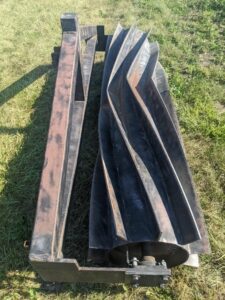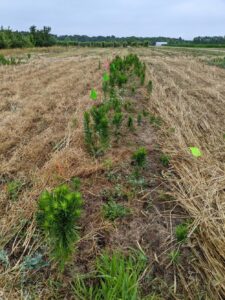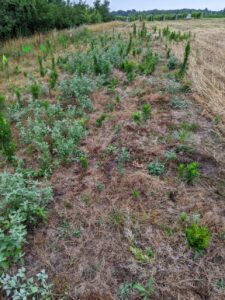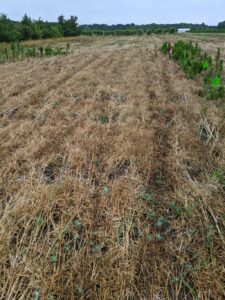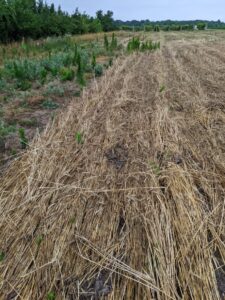Attendees at a July field day at the Meigs Horticulture Research Farm in Lafayette, Indiana saw first-hand the potential of cover crops to suppress weeds in a SARE-funded demonstration plot.
First, some background:
Three cover crop species were sown with a ten-foot drill on September 10, 2021:
- Oats at 100 lb/acre
- Cereal rye at 65 lb/acre
- Rapeseed at 15 lb/acre
The oats winter-killed. The cereal rye and rapeseed did not.
All plots were roller-crimped in early June 2022 using the roller-crimper in Figure 1 which crushed the cereal rye (Figure 2) and rapeseed stems at multiple points and provided excellent cover crop termination.
What we observed (photos taken July 8, 2022):
A small strip of land without any cover crop (Figure 3) contained an abundance of marestail and some lambsquarters. Marestail is a common weed of no-till systems, and many populations of marestail have some level of glyphosate resistance. It often emerges in the fall, but can emerge sporadically throughout the year. Lambsquarters is a summer annual weed common in Indiana.
Winter-killed oats did not suppress weeds and had just as many marestail and lambsquarters as the no cover crop plot (Figure 4).
Rapeseed provided better weed control than oats. This plot contained no marestail, but did contain many small lambsquarters (Figure 5). However, the early June termination timing was too late for the rapeseed plot, resulting in viable seeds being produced and rapeseed volunteers germinating in this plot.
It may come as no surprise that cereal rye provided the most weed suppression with a limited number of weeds visible (Figure 6).
The take-away:
When planted early in the fall and allowed to reach their full potential prior to roller-crimping, cereal rye and rapeseed can suppress common winter and summer annual weeds. However, none of the cover crops provided complete weed control, and winter-killed oats provided no control. Complete weed control may require additional weed control measures such as herbicides. As fall approaches, consider adding cover crops into your overall weed management program.
